Fukutoku Garden opened on Wednesday, September 28
September 28, 2016
Mitsui Fudosan Co., Ltd.
Tokyo, Japan, September 28, 2016 Mitsui Fudosan Co., Ltd. is pleased to announce that ceremonies were held on Wednesday, September 28, 2016, to mark the opening and completion of construction on Fukutoku Garden, in which it had been developing under the Nihonbashi Honcho 2nd District Project.
In Nihonbashi, Mitsui Fudosan is currently working on the Nihonbashi Revitalization Plan, a collaborative public, private and community initiative based on the concept of "Proceeding to Create While Retaining and Reviving." Mitsui Fudosan, as a promoter of the Nihonbashi Revitalization Plan, is undertaking many initiatives. Based on Nihonbashi&requo;s unique identity that includes its history and culture, waterfront space, and local community, Mitsui Fudosan aims to create a neighborhood that combines a variety of functions-where people work, live, play, and relax. The Company is not only developing the tangible aspects of this neighborhood, but also the intangible aspects that create added value. Fukutoku Garden is one part of this plan and was created to be a plaza to enrich and enliven the area.
Fukutoku Garden is over 1,000 m2 adjacent to Fukutoku Shrine and COREDO Muromachi and a public plaza space where people can rest, relax and view landscaping designed to accentuate the four seasons. Fukutoku Garden will also function as an event space for local residents, groups and companies to be a place where people meet and interact to generate new forms of local community. In addition, it will recreate local history and tradition, in part through the relocation of Yakuso Jinja, a long-time fixture of Nihonbashi.
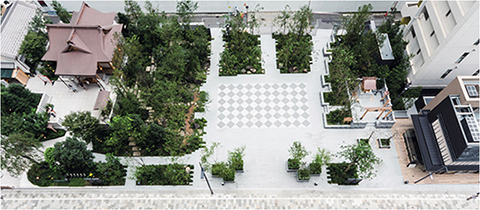
Overall view of Fukutoku Garden
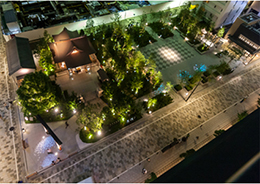
Beautiful light shines warmly on Fukutoku Garden and Fukutoku Shrine together as one
|
 |
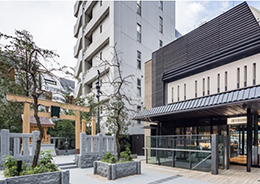
Yakuso Jinja relocated and Mebuki Cafe opened
|
Features of Fukutoku Garden
1. Landscaping
- Comprised of landscaped space with greenery that symbolizes Fukutoku Garden that surrounds the shrine and its approach to express nature, tradition and plentitude, as well as greenery that adds color to cultural and historical sites that encompass Yakuso Jinja.
The landscaping was supervised by Mr. Hachiro Sakakibara, who also handled the design of Hinokicho Park at Tokyo Midtown.
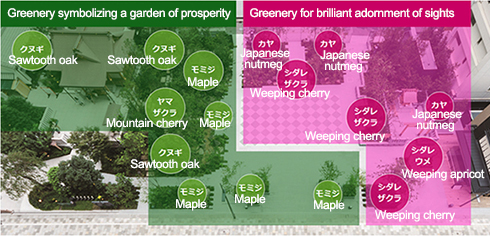
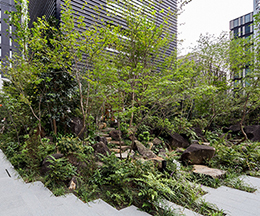
Greenery symbolizing a garden of prosperity
Deciduous broad-leaf mountain cherry, mountain maple, aohada and Japanese styrax trees, along with sawtooth oaks, which have a connection with Fukutoku Shrine, have been planted in mixed arrangements to resemble an old-growth woodland area and provide stunning natural beauty throughout the four seasons.
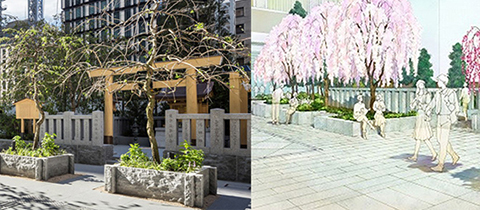
Greenery for brilliant adornment of sights
Weeping cherry and apricot trees, said to bow to welcome visitors to Yakuso Jinja, but which are also quite attractive on their own, have been arranged with evergreen nutmeg trees to express the beauty of contrasting groves during the winter season.
2. Design Elements
- Natural Tsukuba stone is used for all the ornamental stones, washbasins, dry riverbed stones and stepping stones. The central plaza area features large black and white granite in a checkerboard pattern, an expression of Edo culture.
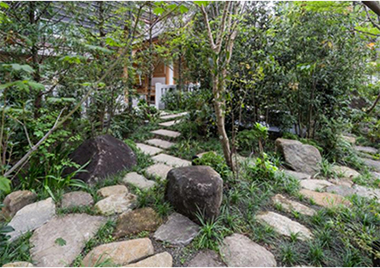
Dry riverbed stones and stepping stones unified with natural Tsukuba stone
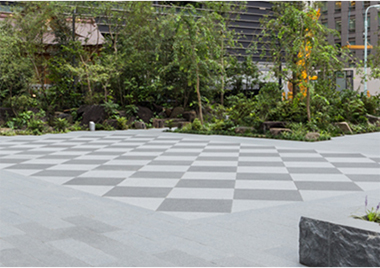
Central plaza area an expression of Edo culture
3. Lighting design
- The lighting design was supervised by Mr. Satoshi Uchihara, whose work is also featured at Kinkakuji Temple and the Phoenix Hall of Byodo-in Temple in Kyoto.
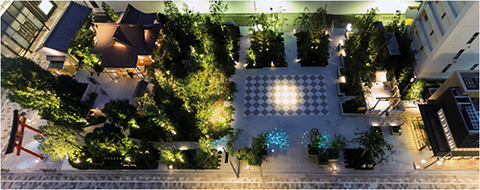
Fukutoku Garden is symbolically embraced by warm, beautiful light integrated with Fukutoku Shrine.
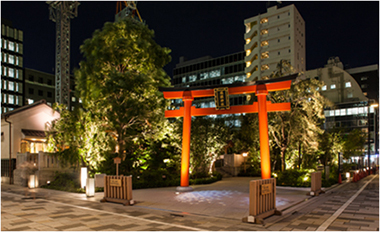
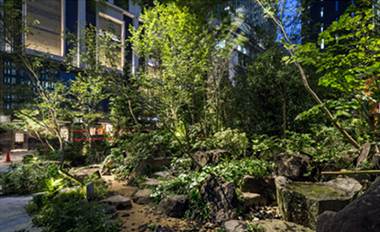
Landscaping symbolizing the four seasons, with spring cherries and autumn maples, is lighted optimally for that season with portable lighting.
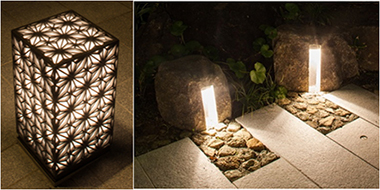
Footpaths are lit with stone lanterns and paper lanterns.
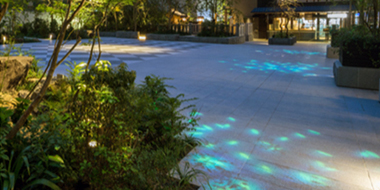
The path running from Fukutoku Shrine and Yakuso Jinja to Mebuki Cafe is inlaid with patterns of light from cherry and oak leaves.
4. New sights in Fukutoku Garden
- There were many medicine wholesalers from the Edo Period. Yakuso Jinja, a symbol of the history of the "Town of Medicine" Nihonbashi, has relocated here.
- The newly opened Mebuki Cafe is also responsible for disseminating information about the history and culture of Nihonbashi.
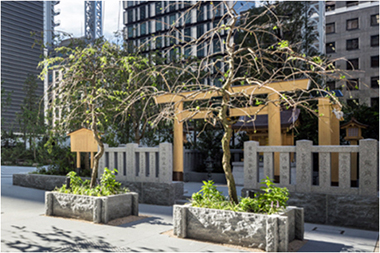
Yakuso Jinja
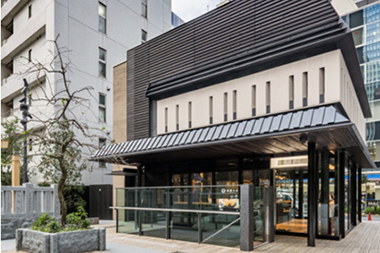
Mebuki Cafe
Profile of Hachiro Sakakibara
Hachiro Sakakibara was born in Shizuoka Prefecture in 1944 and graduated from the Tokyo University of Agriculture’s Department of Landscape Architecture in 1967. He worked at Tokyo Teien from 1967 to 1972 and under Tokyo Teien’s Kenzo Ogata from 1975 to 1976. His major works include Hinokicho Park at Tokyo Midtown, Mohri Garden at Roppongi Hills and Showa Kinen Park’s Japanese Garden. He is one of Japan’s leading landscape designers who theoretically engineers natural beauty based on the belief that design starts fundamentally in nature.
Profile of Satoshi Uchihara
Satoshi Uchihara was born in Kyoto Prefecture in 1958 and graduated with a degree in three-dimensional design from Tama Art University’s Faculty of Art and Design. He joined Motoko Ishii Lighting Design in 1982 and went on to establish Uchihara Creative Lighting Design Inc. in 1994. Mr. Uchihara is committed to creative design that generates urban identities, spatial functions and atmosphere, and that interfaces with end-users by maximizing the possibilities of light, and has provided lighting design for a wide range of facilities, from historical buildings like Kinkakuji Temple and the Phoenix Hall of Byodo-in Temple to state-of-the-art facilities such as Toranomon Hills and the Haneda Airport International Passenger Terminal.
Reference InformationOverview of Fukutoku Garden
| Name |
Fukutoku Garden |
| Location |
Muromachi 2-chome 5-10, Nihonbashi, Chuo-ku, Tokyo |
| Site area |
1,234.54 m2 |
| Designer |
NIHON SEKKEI, Inc. |
| Contractor |
Shimizu Corporation |
| Landscape planning |
Mr. Hachiro Sakakibara |
| Lighting planning |
Mr. Satoshi Uchihara |
| Start construction |
January 2015 |
| Completion of above-ground part |
September 28, 2016
*Overall construction, including underground commercial space, is scheduled for completion
in fiscal 2017. |
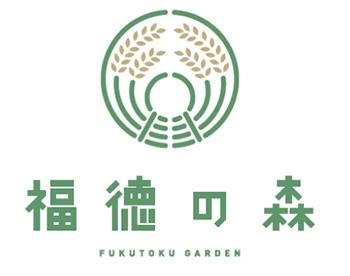
Fukutoku Garden logo
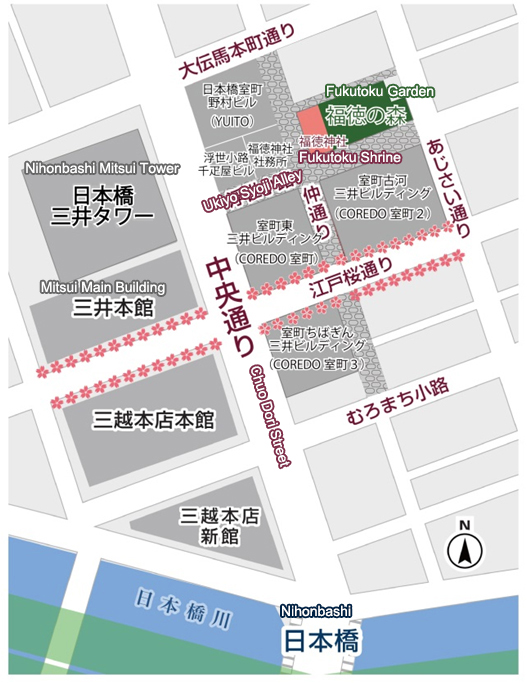
Use of Fukutoku Garden as event space
Fukutoku Garden may be rented for use as event space by corporations and other organizations.
For information on holding events at Fukutoku Garden, please refer to the Nihonbashi Muromachi Area Management website.
http://muromachi-area.jp/ (Japanese only)
About Fukutoku Shrine
It is said that enshrinement had already taken place at Nihonbashi as of the reign of Emperor Seiwa in the Jogan era (859-876). The shrine’s main deity is a god of bountiful harvests called Ukanomitama-no-mikoto. Tokugawa Ieyasu and other generations of the Tokugawa shogunate were among the shrine’s faithful. It is said that when the second shogun, Tokugawa Hidetada, visited the shrine on New Year’s Day in 1614, he praised it saying that “Fukutoku,” which means “good fortune,” is a very auspicious name. The shrine was given another name at this time, “Mebuki Inari,” because the sawtooth oaks trees that formed the shrine gate were newly budding. When construction was completed on the new shrine building in October 2014, the Mebukikai association was formed, mainly comprised of local residents, and it has held and supported the Fukutoku Shrine festival and various other events to promote the shrine and business in the area as Fukutoku Shrine has become the core of the community.
About Yakuso Jinja
Nihonbashi-Honcho’s medicine industry once expressed its reverence by worshipping at Oarai Isosaki Shrine and Sakatsuraisosaki Shrine in Mito and Gojoten Shrine in Tokyo’s Ueno district, which enshrine two deities, Onamuchi-no-kami and Sukunabikona-no-kami, said traditionally to be the ancestral gods of medicine, but in 1908 the Tokyo Drug Trade Association (predecessor of the Drug Trade Association; currently the Tokyo Yakuji Kyokai) received the spirit of the god of medicine from the above-mentioned Gojoten Shrine and held a festival in Nihonbashi-Honcho on November 22 and 23. After that, the festival was held every other year. In November 1929, Yakuso Jinja was built on the top of the association’s building and thereafter enshrined the deity for Nihonbashi-Honcho, becoming a symbol for Nihonbashi as a district of medicine. An annual festival is held every year in October and will be conducted this year on October 14.
Plaza space development plan in Nihonbashi Revitalization Plan
Plaza space is indispensable in a community for enriching people’s lives and instilling a sense of liveliness in a local area.
In Nihonbashi, Mitsui Fudosan is currently working on the Nihonbashi Revitalization Plan, a collaborative public, private and community initiative based on the concept of “Proceeding to Create While Retaining and Reviving.” Mitsui Fudosan, as a promoter of the Nihonbashi Revitalization Plan, is undertaking many initiatives. Based on Nihonbashi&requo;s unique identity that includes its history and culture, waterfront space, and local community, Mitsui Fudosan aims to create a neighborhood that combines a variety of functions-where people work, live, play, and relax. The Company is not only developing the tangible aspects of this neighborhood, but also the intangible aspects that create added value.
Under the Nihonbashi Revitalization Plan, three plaza spaces of over 1,000 m2, including Fukutoku Garden, will be created in the Nihonbashi area.
- Nihonbashi Honcho 2nd District Project
Fukutoku Garden 1,234.54 m2
- Nihonbashi 2nd District Project
Rooftop plaza about 6,000 m2 (scheduled for completion in fiscal 2018)
- Nihonbashi Muromachi 3rd District Project
Plaza about 1,500 m2 (scheduled for completion in March 2019)